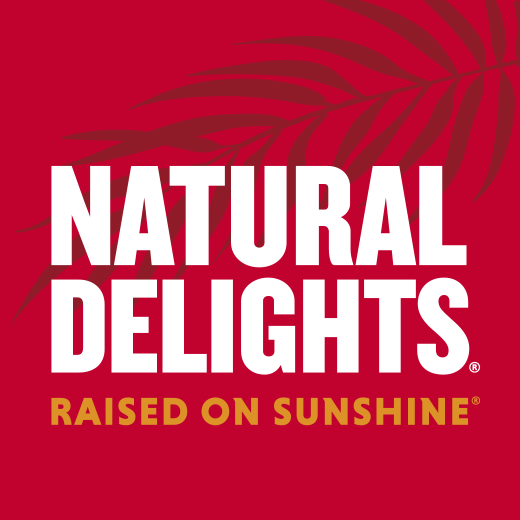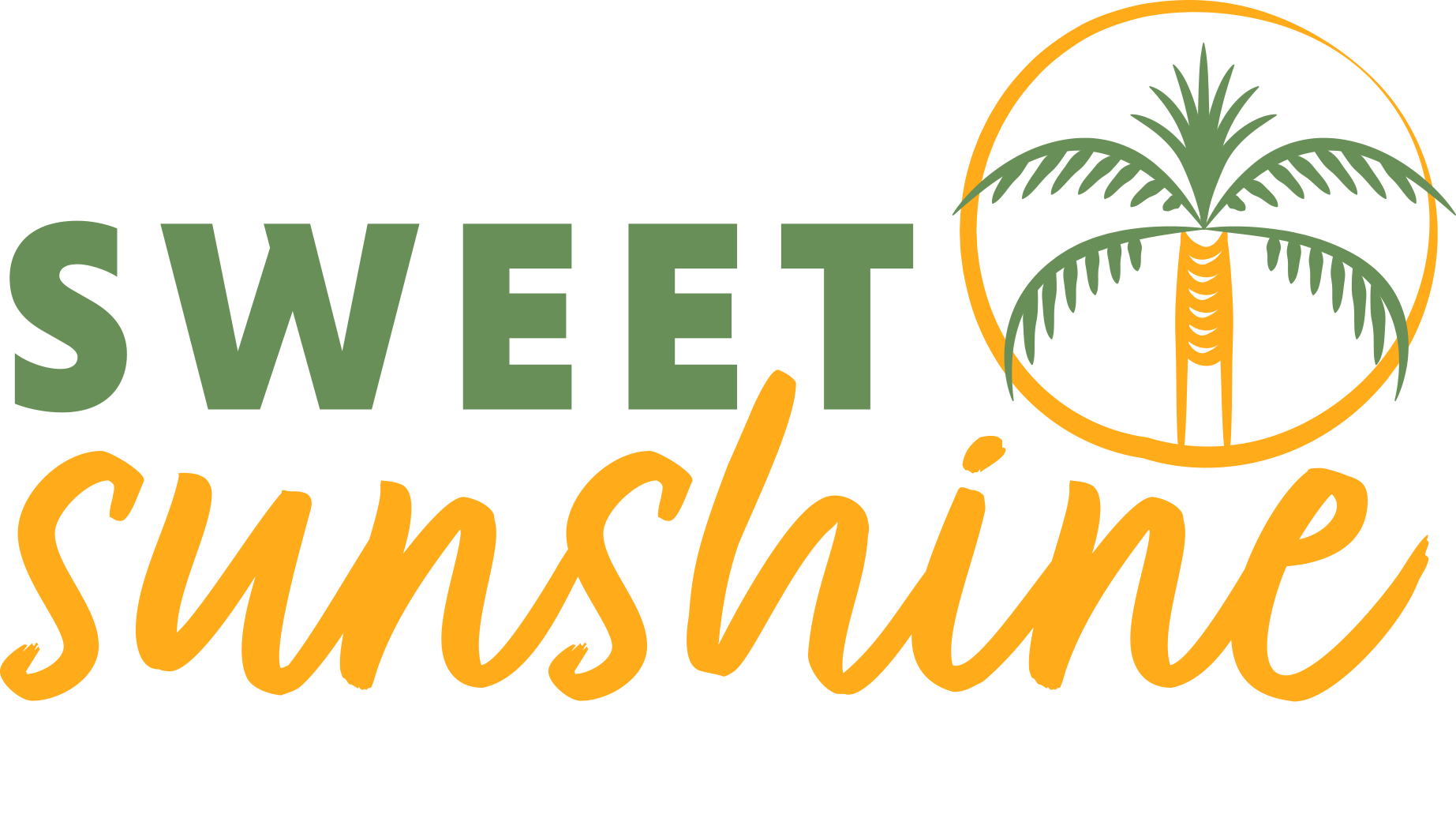
As a Registered Dietitian, I am all about enjoying good food and helping others discover the joy in doing so too. I have been a fan of Medjool dates and the Natural Delights brand for some time now, but this year, I was invited to attend their annual Harvest Tour and it was such a distinct and memorable experience. They invited me out to the Bard Valley near Yuma, Arizona, to see date harvest in action. Here, I’ll take you through the entire process from tree to table - and give you a whole new appreciation for:
For a video recap of my experience at this year’s Harvest Tour, check out my vlog here:
We started in Phoenix, Arizona, where upon arrival I received the most thoughtful SWAG bag. The Natural Delights team truly thought of everything we would need for the tours and put it in the cutest tote bag. Later that night, I got to enjoy a lovely dinner on the patio at the back of the McCormick Scottsdale Hotel. It was great to mingle with dietitian friends and food bloggers I hadn’t seen in a while, and even met some new faces! One of the things that makes this tour so distinct from others I’ve been on is that there’s a much bigger group with people from a variety of backgrounds. There were social media influencers, dietitians, food bloggers, people from retail and sales, and even international folks who flew halfway around the world to be there for date harvest.

(Shweta Garg, Andy Mathis, RD, Lauren Twigge, RD, Hannah Dela Cruz, Chef Rosie Godycki, Kiersten Hickman, Beth Keeton, Cara Harbstreet, RD (me!), and Marta Rivera Diaz at our Harvest Haute themed dinner)
Thursday started with a really early wake-up call so that we could drive to Yuma for the highly anticipated Harvest Field Tour. As we pulled up to the fields, I caught my first glimpse of the Medjool date palms.
Fun fact: Date trees only grow in a very specific type of climate and environment. Their ideal growing conditions include:
Once we pulled up, we stepped right into the middle of a forest of palm trees. The Medjool date palms were a sight to see. And I don’t know about you, but I had no idea that dates grew off palm trees like that!
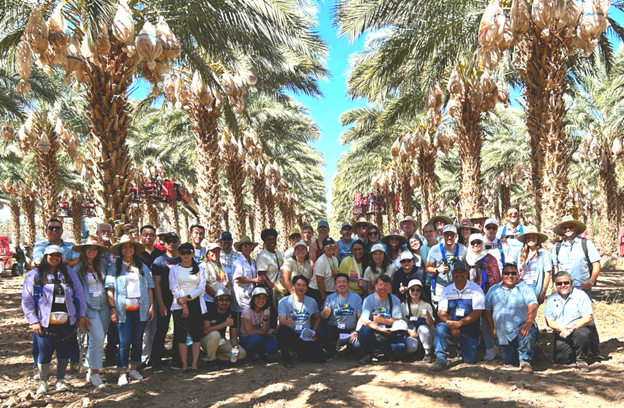
(Our entire group, including RDs, influencers, media, retailers, Natural Delights sales & marketing and growers)
We had a few minutes to take in the view, then jumped right into the good stuff. And by good stuff, I mean tasting a date that was literally picked MINUTES before we got there. We were briefed on the bus about the growing and harvest process, and I learned that Medjool dates have a really interesting history. I’m going to share the super short version with you!
Overall, growing and harvesting dates is an incredibly labor-intensive process. It requires multiple trips into the treetops to tend to the fronds, prepare the pollen for setting fruit, thin out the strands, cover them with mesh bags to protect them from birds and pests, and finally - start to harvest the ripe dates in late summer. After taking all of this in, it was finally our turn to get harnessed up and taken into the uniquely designed lifts. Date palms can be more than 40 feet high, so it’s extremely important to keep the farm workers as safe as possible. Harvesting can only be done by hand, which means dispensing the dates out of the mesh bags where they are then sorted onto colored-coded trays according to which farm grew them.
Fun fact: A single tree can yield up to 200 pounds of dates!
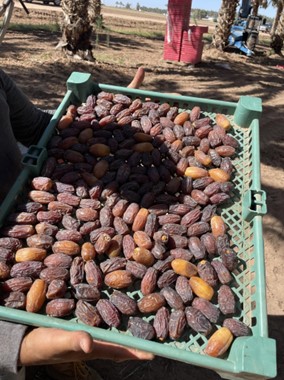 Some dates must be discarded due to defects or just not being ripe enough. But the date industry is making an effort to be more sustainable, finding creative ways to use discarded dates for animal feed. The pits can also be repurposed into tubs to help reduce plastic use.
Some dates must be discarded due to defects or just not being ripe enough. But the date industry is making an effort to be more sustainable, finding creative ways to use discarded dates for animal feed. The pits can also be repurposed into tubs to help reduce plastic use.
After having some downtime later that afternoon, we all met up for a Harvest Haute-themed dinner. It was a great time with amazing food, and I had a grower at my table who shared a lot more about the story of his family and how they got into the date business in the first place - which was really cool to hear!
Friday’s tours were at Natural Delights’ packing facilities. Datepac East and Datepac West are where we got to see the next step in the process. After the dates are harvested from the trees, they’re brought to these facilities. We had a very specific dress code (long pants, closed-toed shoes, hair nets, and no jewelry) because of how important food safety is in the packing process. It was a rare thing to be able to film as much as I did inside the facility. But Natural Delight is super transparent and they gave me the green light to film any part of the process.
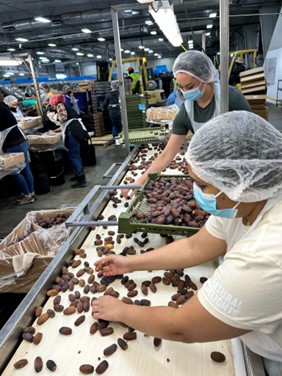 Once at the sorting line, dates are graded according to how much moisture they have. The goal was to separate Grade 2 dates (which are ready to pack) from Grades 3, 4, and 5, which either need more time to dry or will be processed into something other than whole dates. The first thing we did was attempt to sort but it was not easy work by any means! From here, the ready-to-pack dates are sent on while the rest are transformed into these giant warehouse rooms. They basically replicate the environment of the top of a date palm tree. These rooms can hold up to 50,000 pounds of dates EACH. This helps bring down the moisture to about 17-22%. At that point, the dates can withstand the jostling around of the packing process.
Once at the sorting line, dates are graded according to how much moisture they have. The goal was to separate Grade 2 dates (which are ready to pack) from Grades 3, 4, and 5, which either need more time to dry or will be processed into something other than whole dates. The first thing we did was attempt to sort but it was not easy work by any means! From here, the ready-to-pack dates are sent on while the rest are transformed into these giant warehouse rooms. They basically replicate the environment of the top of a date palm tree. These rooms can hold up to 50,000 pounds of dates EACH. This helps bring down the moisture to about 17-22%. At that point, the dates can withstand the jostling around of the packing process.
What was really cool was that just steps beyond the processing facility was another bunch of date palm trees. This means that the dates make their way from the field to the sorting line within 24 hours of being picked. Everything starts to move extremely fast at this point as the dates move down the conveyor belts. They’re given a quick rinse, which removes about 98% of any remaining dust or debris, and then they’re sorted by size and weight. It’s amazing how fast this machine is able to do it accurately! Depending on which orders or retailers they’re packing for, the dates are then sorted into the proper categories and portioned out with this giant “hopper.” Many things are automated but some jobs are still done by hand. Packages are then sealed and carefully labeled for traceability purposes.
Dates that don’t make the cut are destined for what the industry calls “a value-added product” such as these Mini Medjools. They’re smashed into a date paste then frozen and either mixed with other ingredients or rolled in coconut to create this really yummy snack. We got to taste one off the line and it tasted SO good!
Fun food trivia: Dates are actually considered a fresh fruit, not dried!
Once the tours were wrapped up, I was back at the Phoenix airport to catch my flight home!
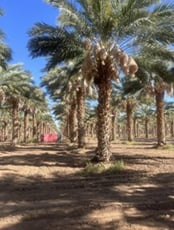
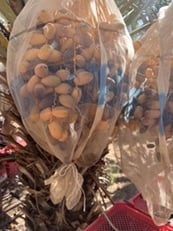
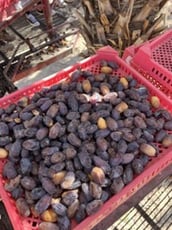
(Photos from my time in the fields including the trees, bagged dates, and harvested dates)
All of this was a brief synopsis, but I hope this has taught you a lot more about a really cool ingredient - dates! They have such an interesting story behind them and as you saw, there’s so much technology and innovation that helps them go from the tree to the grocery store. I think it’s always SO impressive how much care and attention goes into growing our food and creating food that nourishes us in so many delicious ways. The date-growing and -harvesting process was so cool to see first-hand and gave me a new appreciation for the hard work it requires. It makes me feel so grateful for all of the human effort that goes into feeding us. I hope this has been as insightful to you as it has for me!
Cara Harbstreet, MS RD LD is a Kansas City-based registered dietitian and the owner of Street Smart Nutrition. She is a nationally-recognized food and nutrition expert, author, and consultant. She is passionate about helping people rediscover joy in eating deeply nourishing meals without restriction or fear, and enjoys candid conversations about the food system, nutrition, and cooking. Cara is also the author of “Healthy Eating for Life: An Intuitive Eating Workbook” plus two cookbooks, and actively volunteers within the dietetics profession. To learn more about Cara, visit streetsmartnutrition.com.
Subscribe for fresh recipes, helpful tips, and exclusive offers!
